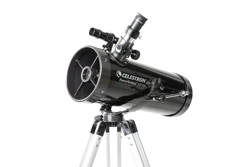Loading ...
Loading ...
Loading ...

ENGLISH | 5
With the Moon visible in the sky, set up your telescope
as described above with the 20mm eyepiece installed.
Move the telescope so that it is roughly pointing toward
the Moon.
2
Look through the fi nderscope and locate the crosshair
reticle. Continue moving the telescope until the
crosshair appears over the Moon.
3
Look through the telescope’s 20mm eyepiece.
Gently turn the focus knobs to adjust the sharpness
of the image.
You can view many other celestial objects, such as
planets, star clusters and nebulae using this same
technique if you know where to fi nd them in the
night sky.
Celestron’s free SkyPortal app for iOS and Android can
help you locate and identify a wide array of celestial
objects quickly and easily.
CONGRATULATIONS!
YOU HAVE NOW OBSERVED YOUR
FIRST CELESTIAL OBJECT!
To get a closer view of the Moon, loosen the set
screws on the focuser and remove the 20mm eyepiece.
Replace it with your 4mm eyepiece and tighten the set
screws to secure it in place. The 4mm eyepiece will
give you signifi cantly more magnifi cation, making the
Moon appear much larger.
NOTE: You may need to adjust the focus
knobs when you change eyepieces, so
make sure you are getting the sharpest
image possible.
4
1
5
The best and easiest target for you to try to view fi rst is the Moon. Try
observing the Moon at different points in its phase cycle. The best time
to view the Moon is from two days after a New Moon up to a few days
before a Full Moon. During this period, you will be able to see the most
detail in the craters and lunar mountain ranges.
YOUR FIRST NIGHT OUT
THE MOON
6
Loading ...
Loading ...
Loading ...
